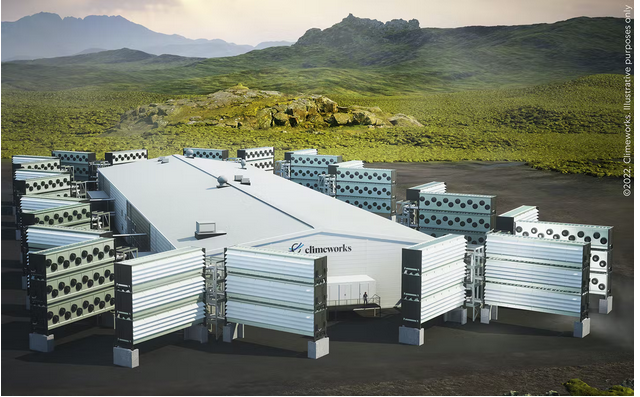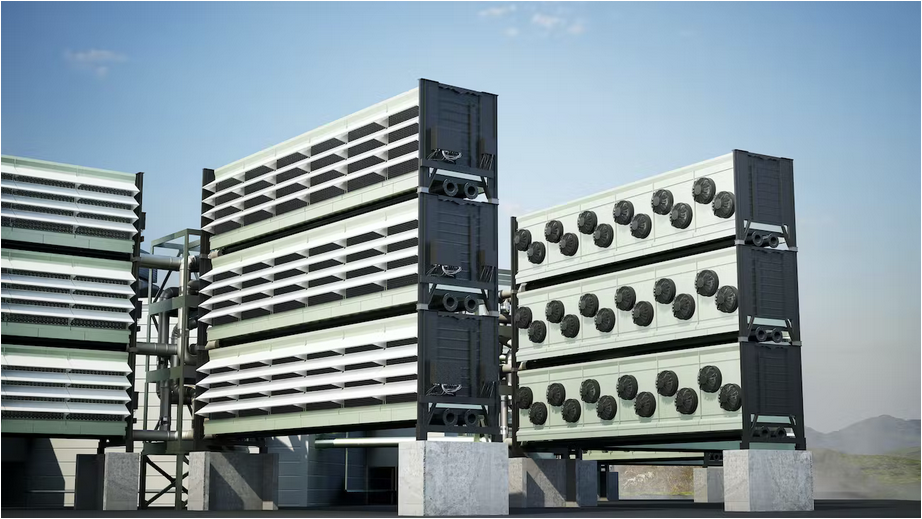
Less than a year after putting the world’s only commercial direct air capture & storage (DAC+S) plant Orca into operation, Climeworks announced the groundbreaking of Mammoth in June 2022.
Orca represents the first deployment of Climeworks’ second technology generation. Mammoth is based on the same technology, but multiplies Orca’s capacity by factor of 9 – a demonstratable step in Climeworks’ ambitious scale-up plan: megaton capacity by 2030 and being on track to gigaton capacity by 2050.
Today, the construction of Mammoth is well underway. While 2022 ended with the completion of Mammoth’s process hall cladding, 2023 kicked off with the start of the CO₂ collector container production.

The role of Mammoth’s CO₂ collector containers
The CO₂ collector containers (abbreviated as CCs) are a core component of Climeworks’ direct air capture (DAC) plants: they are the ones capturing CO₂ from the air. Mammoth will consist of 72 CCs (in contrast to the 8 CCs deployed at Orca), three of which are stacked together on one foundation (vs. two at Orca).
The CCs were fully developed and designed by Climeworks and represent the modularity of Climeworks’ DAC technology. Modularity means that units are produced in standardized dimensions, which allows for easy assembly and flexible arrangement. Climeworks’ CCs were designed to enable mass production: the handling of the CCs during construction is simple thanks to its dimensions – they can be flexibly moved around with a reach stacker (a vehicle that can stack, load or unload containers) and are easily stackable. This, in turn, simplifies maintenance work and enables the implementation of upgrades by improving and optimizing the technology and its operations throughout the lifetime of the facility.
This can be compared to solar panels, which are the modular units of photovoltaic systems: panels can be flexibly added to the system in order to increase the voltage required. They are also easy to maintain or exchange in case of damage.
Scalability thanks to modularity
Modularity is a prerequisite to Climeworks’ ambitious scale-up roadmap. To maximize our chances of limiting global warming to 1.5°C above pre-industrial levels, carbon dioxide removal (CDR) solutions such as direct air capture and storage (DAC+S) need to be scaled to gigaton capacity by 2050. To put this into perspective: achieving a DAC capacity of 1 megaton would theoretically require 28 plants similar to Mammoth, as opposed to 250 similar to Orca.
This is why Mammoth, while being the first of this scale to be built and most probably the world’s largest DAC facility to be ever operated in the real-world by the time it is completed, remains one milestone among a series of scale-up iterations on the journey towards gigaton scale.
This massive scale-up is not limited to plants themselves, but spans the whole industry in the coming decades, from the supply chain – providing parts needed to manufacture DAC plants, such as valves, sorbent material, or CCs – to the demand side, i.e. customers that purchase carbon dioxide removal services.
It is therefore crucial that the parts needed to manufacture DAC plants can be easily produced on a large scale – something that is inherent in the proprietary design of Climeworks’ CCs.
The CCs have entered the manufacturing phase in the first quarter of 2023, which is progressing well. However, the current global challenges in supply chains are also impacting our CC production. We are working to recover delays being experienced at our metal fabrication facilities to remain on track with the ambitious construction timelines of the Mammoth project.
Douglas Chan, Chief Operating Officer at Climeworks; “Sometimes I am getting asked why we don’t just build 10,000 Mammoths. The simple answer is that the supply chain for this does not exist yet. No market player can currently produce 10,000 x 72 CCs. 720,000 CCs are just not available on the world market today. The development of deep supply chains needs time and requires maturation of an ecosystem. Without long-term certainty on market growth and demand, suppliers have a hard time allocating production capacity to DAC. That’s why the market demand shown by companies such as Microsoft, BCG or Swiss Re on the voluntary market is so crucial to accelerate the DAC industry’s growth. Demonstrating to suppliers that deployment is possible by building DAC plants, and that demand exists from our customers, are the first steps towards establishing a stronger supply chain base.”
Producing 72 CO₂ collector containers
In this context, producing 72 CCs is an important scale-up step that Climeworks takes: never before have 72 DAC CCs been produced.
The CCs undergo the following main production steps:
- Raw material: the raw material is transported to the production site, which is located in Western Europe.
- Manufacturing: the elements of the CCs are manufactured through cutting and welding.
- Assembly: the different parts of the CCs are put together and tested.
- Transport: the CCs are ready to be transported to the Mammoth site in Iceland, where they will be further prepared for commissioning.
Climeworks fully accounts for the CO₂ emissions caused by the production steps as well as the transportation of the CCs – they will be subtracted from Mammoth’s capture capacity. In other words, Mammoth will remove its own footprint. In the end, only the net CO₂ removal is offered and sold to Climeworks’ customers.
Source
Climeworks, press release, 2023-03-21.
Supplier
Share
Renewable Carbon News – Daily Newsletter
Subscribe to our daily email newsletter – the world's leading newsletter on renewable materials and chemicals












